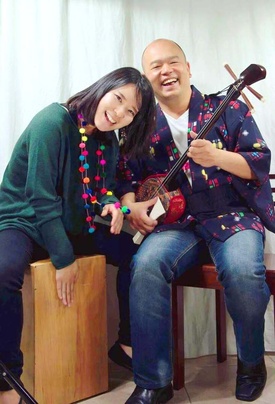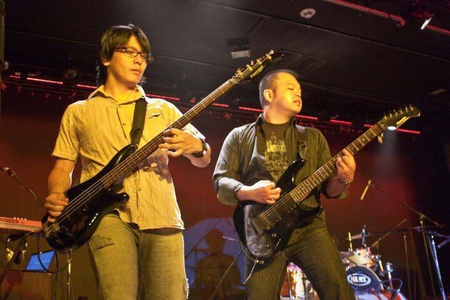
They have been recording videos of their musical improvisations for a couple of months, but the way they get along and enjoy their jam sessions seems like they have been doing it for years. Melissa Araki and Marco Shimabukuro are two young Peruvian musicians capable of playing any instrument they can get their hands on. Together they have formed a nice duo with which they fuse Japanese, Peruvian and rhythms from around the world, with sticky joy.
They met 10 years ago but hadn't had many opportunities to play together. One day they decided to do a musical improvisation and they were both surprised by how easily they understood each other. The chemistry of sanshin and Peruvian cajon that they knew how to combine can already be seen in a first video recorded in May of this year, with no greater pretensions than to enjoy music, a passion that they bring with them and that has led them to experiment with various genres.
Today, the label of Meli & Marco's Jam Session Show , the name under which they hope to soon start releasing singles and having more performances, seems to be the play with instruments (they have an innumerable collection) and musical genres (from bossa to saya, through rock, zamba, landau and Okinawan min yoo), through which they travel with limitless curiosity and fresh air, although they are not new to the Peruvian circuits of Japanese music.
Marco, self-taught
From a young age he knew that he wanted to dedicate himself to music, but he was in no hurry to learn it in the traditional way. He mentions the bassist Víctor Wooten when he wants to explain how being self-taught gave him the freedom to play the instruments without following the canons that can limit the creativity of the composer. Before coming to Japanese music where he has become known, he experimented with rock (bass and keyboards).
“In my school days I was a rocker. Later I became integrated into the Peruvian-Japanese community and discovered Japanese music,” says Marco, who learned to play the sanshin at the Peruvian-Japanese Association. In 2001 he joined the Haisai Uchina group, of Okinawan music, and in 2005 he formed the band Hayabiki, one of the most popular J-pop and J-rock bands in Peru. “It was a time when these rhythms had a great heyday. I feel like I completed a stage and I wanted to try other things,” says Marco.
In 2010 he joined the group Okinawa Champuru and Ravn6, with whom he began to do fusion and experiment with the fusion of Okinawan music, progressive rock, jazz, funk and heavy metal. Today, sounds have been added to these multiple influences in which instruments (strings, winds, percussion) are privileged in minimalist presentations (many of them without lyrics) that are small demonstrations of their rhythmic skills.
Meli, musical
He learned to sing and play the piano at the age of four, but music lives in each of his movements. “As a child I would listen to a song and, as if it were a plate of food, I would stop to identify the instruments,” says Melissa Araki, whose musical ability has allowed her to play almost any instrument and has led her to follow in her father's footsteps. , George, member of the group Yoshi y Los Blue Stars, which plays popular songs from the sixties and seventies.
Flute, ukulele, sanshin, cajon or the taishogoto (a Japanese string and key instrument) are among his extensive repertoire. But it is the piano that occupies his daily schedule, since he dedicates himself full time to giving private lessons at home to children (from four years old) and adults. Recently, a group of 20 of his students gave their first recital. “I like to get to know the kids to create a space where they feel comfortable and it is easier for them to learn.”
Meli, who studied piano with the Kodaly methodology, has played with various Nikkei groups from Peru, such as Beto Shiroma and Claudia Oshiro, and was a member of the Japanese rock group Akasia. He also lived for a time in Japan, where he did voices for the Yamaha company. It was an exciting experience, she says, that made her see something that transmits in its natural spontaneity: “music is made to be enjoyed, there is nothing more free,” she says with the enthusiasm that is contagious when watching her play or sing.
Versatility and sound
Meli and Marco use different instruments in their creations, but one of their favorite duets is the Japanese sanshin (which Marco plays in the style of tsugaru-shamisen) and the Peruvian cajon. His first video has more than 12 thousand views and is a tribute to this oriental instrument. In the following, improvisation reaches innovations such as the ' zambandina ', a rhythm inspired by Brazilian music but played with cajon and charango.
Folklore permeates some of his compositions, as well as the intention to give him a mixed identity, such as his fusion of the Andean saya and the Okinawan min yoo, Afro-Peruvian rhythms played with sanshin or oriental ones with violin, guitar and cajon. You can also hear, among the more than 10 videos they have published in two months, jazz with a bossa feel, a melody inspired by military marches and even a song by The Beatles in which you can also appreciate their vocal quality.
For songs like these they multiply and record more than one instrument and then mix them. “The ideas for songs sometimes come to us while chatting. I send an audio to Meli, or she shares something she's listening to, and that's where we start,” says Marco. The festive tone makes one believe that there is an entire orchestra but the images do not deceive: in the song “ Latinawense ” you can hear four instruments played by these two Peruvian talents.
New challenges
Meli & Marco's Jam Session Show has already been performed at events such as the 110th Anniversary of Okinawan Immigration, the 50th Anniversary of Residencial San Felipe and the tenth anniversary of Uruma. They are full of ideas and projects, such as joining networks to share music on Apple Music and Spotify. “Now there is more opportunity to disseminate independent artists,” says Marco.
The possibilities seem endless for this pair of multi-instrumentalists capable of finding unexpected sounds in a short time, the same ones that are bringing many Peruvians closer to Japanese rhythms and instruments. They still have many more waiting to appear in their videos, such as the koto, the Japanese harp.
“It is delicious to bring together instruments from different origins, it is as if people from different origins started to talk about their cultures, their evolution and their emotions,” Meli has written. For now, this year they hope to be at the Matsuri and show part of that dialogue of instruments with which they spread their passion for music.

© 2016 Javier Garcia Wong-Kit







